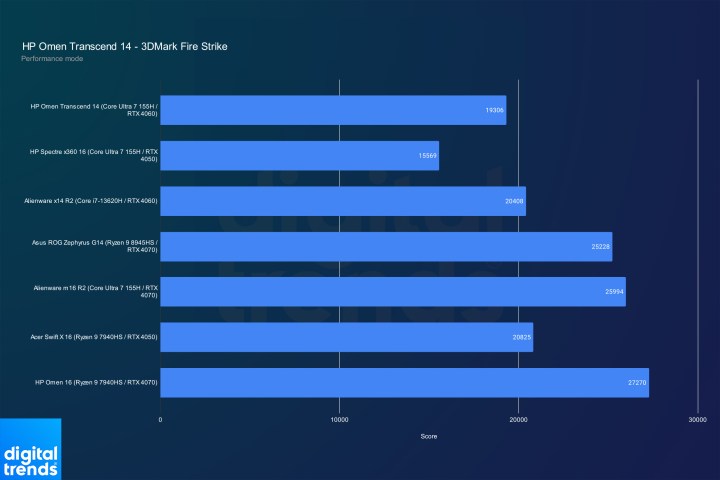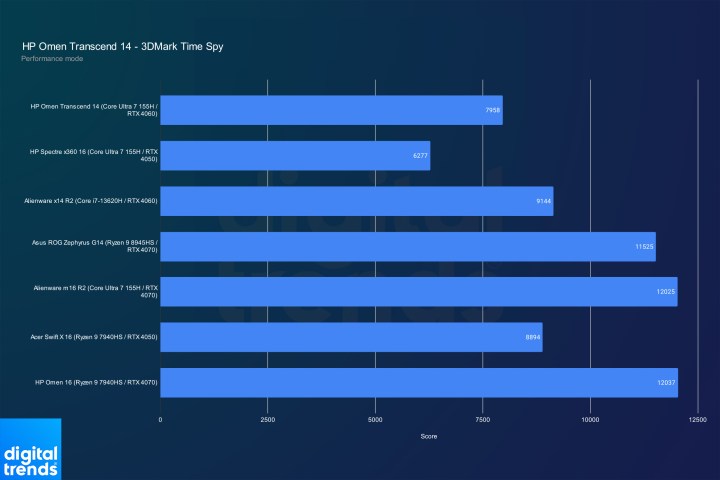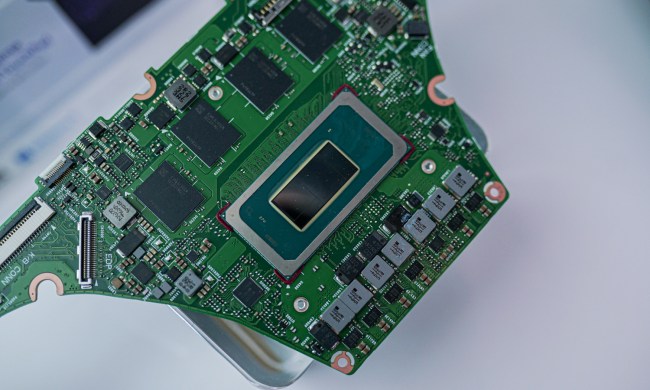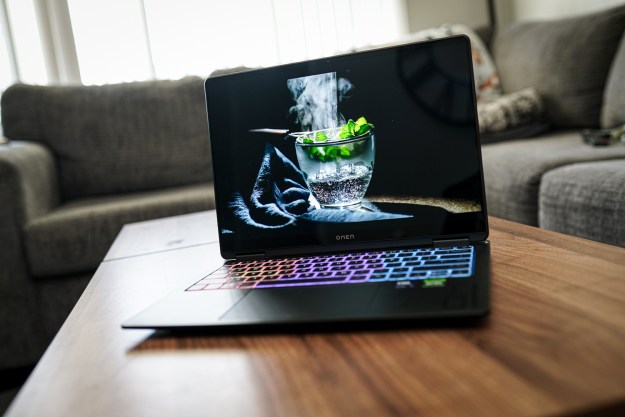
“HP's Omen Transcend 14 is an impressive first step into premium gaming laptops.”
- Beautiful OLED display
- Solid aluminum body
- Excellent port selection
- Great CPU performance
- Slightly behind in gaming
- Exclusively uses USB-C for charging
HP is stepping up its laptop game. Although its Omen range of laptops have never been bad, a focus on value over build quality and features have kept most Omen machines off the list of the best gaming laptops. The Omen Transcend 14 is a step into more premium laptop designs, albeit with a few stumbles.
It’s a thin and light 14-inch gaming laptop with a stunning OLED display and a price that’s highly competitive with options from Asus and Razer. Some strange choices in specs hold back the performance of the laptop, however, but I hope to see them resolved in the second iteration of this machine.
HP Omen Transcend 14 specs
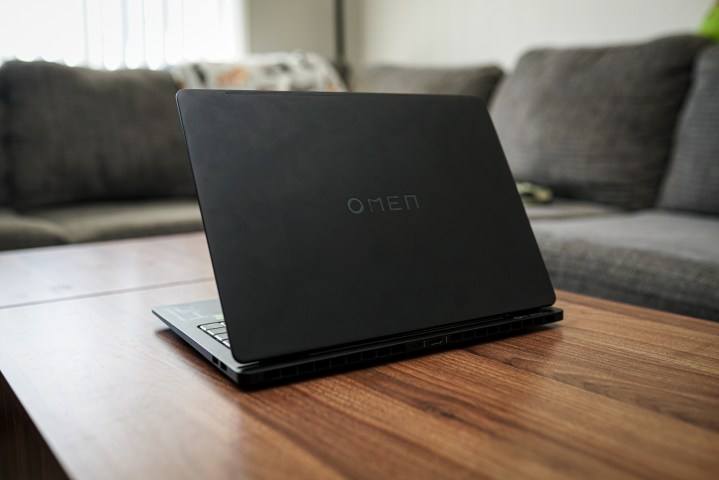
HP offers the Omen Transcend 14 in a few different configurations, and unlike competing laptops from Razer and Asus, HP bases the design around one of Intel’s new Meteor Lake CPUs. HP ties the CPU and GPU choices together, so you don’t have an opportunity to mix and match the handful of options.
Both the RTX 4050 and RTX 4060 configurations come with a Core Ultra 7 155H, which is a 16-core CPU that can boost up to 4.8GHz. The RTX 4070 configuration comes with a Core Ultra 9 185H, which also features 16 cores, but with a higher 5.1GHz boost clock. This configuration also comes with 32GB of soldered memory, while the other configurations are stuck at 16GB.
It’s strange that HP stuck with Intel’s CPUs for this generation around how they compare to the competition from AMD for gaming performance (more on that below). My bigger issue is the memory configuration, however. Given that this is soldered memory, it would be nice to see a 32GB option across configurations to give the laptop a bit more life.
| HP Omen Transcend 14 (2024) | |
| Dimensions | 12.32 x 9.19 x 0.67 inches |
| Weight | 3.6 pounds |
| Processor | Intel Core Ultra 7 155H (16 cores, 4.8GHz boost clock) |
| Graphics | Nvidia RTX 4060 (90W TGP) |
| RAM | 16GB |
| Display | 2.8K (2,880 x 1,800), OLED, 16:10, 120Hz |
| Storage | 1TB PCIe 4.0 NVMe SSD |
| Touch | N/A |
| Ports | 2x USB 3.2 Gen 2 Type-A, 1x Thunderbolt 4, 1x USB 3.2 Gen 2 Type-C, 1x HDMI 2.1, 1x 3.5mm headphone |
| Wireless | Bluetooth 5.3, Wi-Fi 6E |
| Webcam | 1080p with Windows Hello |
| Operating system | Windows 11 Home |
| Battery | 71 WHr |
| Price | $1,700 |
| Where to buy |
For storage, HP oddly doesn’t default to 1TB, which is what we see with other 14-inch gaming laptops. A base configuration on HP’s website starts at a 512GB SSD, and upgrading that to 1TB is a $90 upcharge. Thankfully, the preconfigured options available at a retailer like Best Buy start with 1TB of storage, so this shouldn’t be issue unless you’re ordering the laptop directly from HP.
One option that remains the same across configurations is the 2.8K OLED display. This is the same display we saw on the 2024 Asus ROG Zephyrus G14, and it’s gorgeous. I have some questions about the resolution, but I’ll dig into those later.
Pricing falls directly where I’d expect. The RTX 4070 configuration is $2,000, matching the price of the 2024 Zephyrus G14 and coming in $700 cheaper than the Razer Blade 14. Interestingly, the RTX 4060 is $1,700, which is $100 more than what Asus is asking for a similar configuration.
A sleek design

The Omen Transcend 14 might be the best-looking gaming laptop HP has ever made. It takes cues from HP’s more mainstream designs like the Spectre x360, with rounded edges on the exterior, as well as the lid and body of the laptop. This doesn’t look like a gaming laptop, and in this category of 14-inch laptops that’s trying to do everything under one roof, that’s a good thing.
The body is made from aluminum, though it doesn’t feel nearly as premium as something like the Razer Blade 14. I’m not sure if it’s the thickness of the aluminum or the overall construction, but there’s a bit of flex on the key deck. I’m not worried in the slightest about the durability of the laptop, especially given the robust screen hinge, but the feel in your hands falls slightly short of the most expensive Blade options.
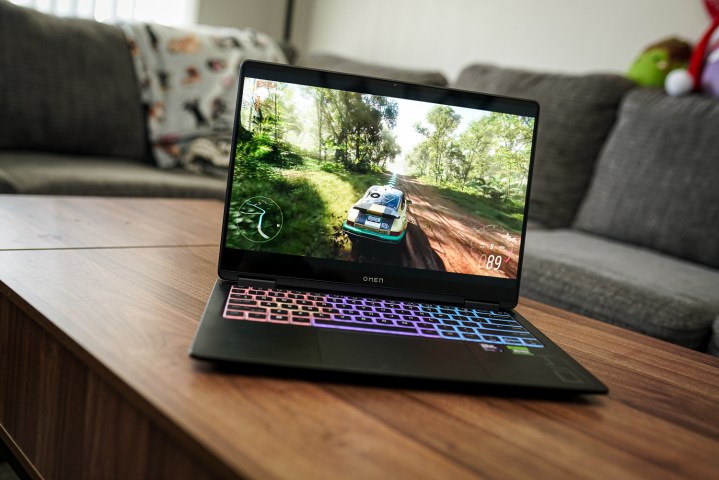
It’s a fair trade-off for a laptop that’s significantly cheaper, however. Elsewhere, HP even has an edge. The Omen Transcend 14 is surprisingly thin at 0.67 inches in the front and 0.71 inches in the rear, matching what Razer offers, but HP’s laptop is significantly lighter at 3.6 pounds. Asus still has the lead in portability with its 2024 Zephyrus G14 at 3.3 pounds, but HP isn’t far behind.
Between the Razer Blade 14, Omen Transcend 14, and Asus Zephyrus G14, HP falls squarely in the middle. This isn’t the thinnest or lightest, nor the thickest or heaviest, and its design, although attractive, is a bit more pedestrian than what you’ll find on competing laptops. Whether that’s a positive or negative is up to you.
Ports

The Omen Transcend 14 has a standard port selection, matching exactly what you get on the 2024 Zephyrus G14. There’s an HDMI 2.1 port, a 3.5mm headphone jack, two USB 3.2 Gen 2 Type-A ports, a USB 3.2 Gen 2 Type-C port, and a Thunderbolt 4 connection. Both the USB-C ports are capable of power delivery and DisplayPort modes, while the Thunderbolt 4 connection is also used for charging.
Although there are two USB-C ports technically, you’ll be occupying one for charging most of the time. HP also uses a 140-watt USB-C charger, which isn’t large enough to run the GPU and CPU at their maximum power. Similar to the Alienware x14 R2, it feels like you hit a performance wall in certain titles, particularly the most demanding games like Cyberpunk 2077.
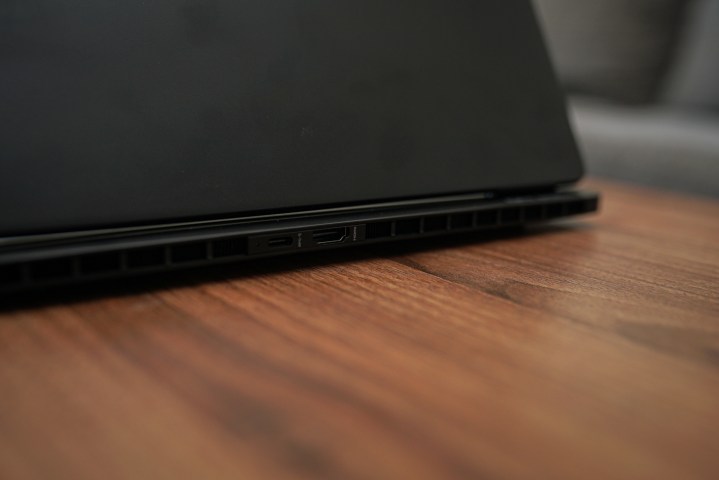
HP lays out the ports in an interesting way. The USB-C port you use for charging is around the back of the laptop, along with the full-size HDMI 2.1 port. This keeps the bulkiest connections out of your way, and I love the design. On the right, you’ll find the two USB-A ports near the back of the machine, and on the left, the remaining USB-C and 3.5mm headphone jack are centered.
It’s a great selection and a solid layout, but I’m still questioning the choice to use USB-C for charging. It’s not a huge deal with the RTX 4060 configuration I reviewed, but the RTX 4070 configuration comes with a more powerful GPU and CPU, as well as more memory, and uses the same port for charging.
Keyboard and touchpad
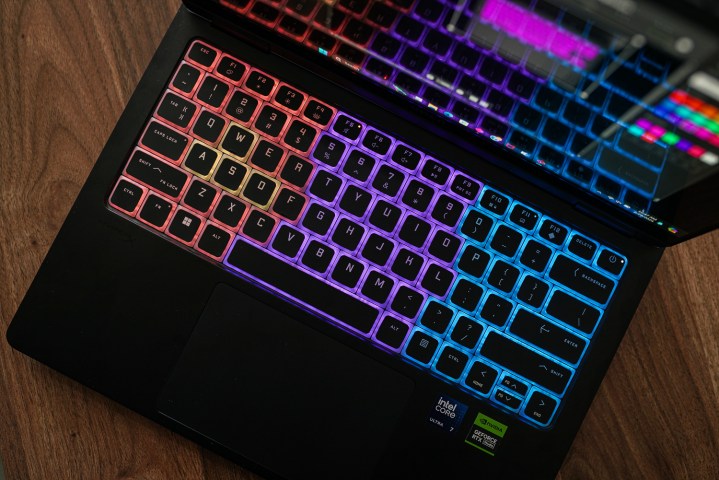
The Omen Transcend 14’s keyboard is passable, but it’s far from the best I’ve used for this class of laptop. The Razer Blade 14 and Zephyrus G14 remain the champs for 14-inch gaming laptops, with the Zephyrus coming out ahead due to a slightly longer travel. The Transcend 14 has a similarly long travel, but it’s not as snappy in the process — bottoming out the keys feels a bit mushy.
Still, it’s a solid keyboard that gets the job done for long typing sessions. My main issue is the RGB lighting. HP uses transparent edges around the keycaps, allowing the RGB lighting to shine through. It looks great when the keyboard is all lit up, but with RGB off, it cheapens the look of the laptop overall. That’s going to come down to personal preference, however.

HP says it will have a version of the Omen Transcend 14 with per-key RGB lighting in the coming months, but this initial run only features four zones of RGB lighting. Setting the keyboard to a solid color looks great, but any sort of pattern movement exposes the zones too clearly.
On top of that, the rate at which the RGB lighting updates is very slow. HP includes a handful of gradients that cycle across the keyboard, but they flicker and stutter when transitioning between colors. It doesn’t look good, and I expected more attention to detail on such an expensive laptop.
The trackpad is spacious, with rounded corners that match the laptop body. It’s not quite as big as the trackpad on the Razer Blade 14, but few laptops can match that standard. Size isn’t the issue here; feel is. There’s a lot of distance when you press the trackpad, and I’m a worried about how long it will hold up over time.
Display

This screen is beautiful. This is the same display we saw on the Zephyrus G14 this year, and it looks just as good on the Omen Transcend 14. It’s a 2.8K OLED display with a 120Hz refresh rate. That’s a resolution of 2,880 x 1,800, which is a pretty large jump from the 1600p displays we typically see in 14-inch laptops.
That has implications for performance, which I’ll dig into later. The clarity of such a high resolution is fantastic, though. You’re getting a pixel density of over 240 pixels per inch (PPI), which gets close to what you see with a MacBook. It looks great on the desktop.

As you might suspect, color is off the charts as well. I measured 95% of AdobeRGB and 100% of DCI-P3, which is excellent coverage, as well as a total color error of just 0.84. This is exceptional color accuracy and coverage, which shouldn’t come as a surprise for an OLED display.
Brightness can’t reach the level of an OLED monitor like the Asus ROG Swift PG27AQDM, but it’s still solid for a laptop. In SDR, I measured 381 nits, while in HDR, the screen peaked at 606 nits, both for a 1% window.
CPU performance
The Core Ultra 7 155H hasn’t been a star in our benchmarks, but it’s surprisingly potent in the Omen Transcend 14. I suspect that has something to do with HP’s dynamic power allocation, as well as some key updates for Intel’s latest laptop CPUs. Still, it’s a bit behind what’s available on the AMD front for gaming laptops right now.

In Cinebench R24, you can see that in action. Despite the Omen sporting twice as many cores, the Ryzen 9 8945HS in the Zephyrus G14 ranks higher. There’s some amount of throttling going on due to the size of the laptop, too — the Alienware m16 R2 with the same number of CPU comes in significantly ahead in the multi-core test.
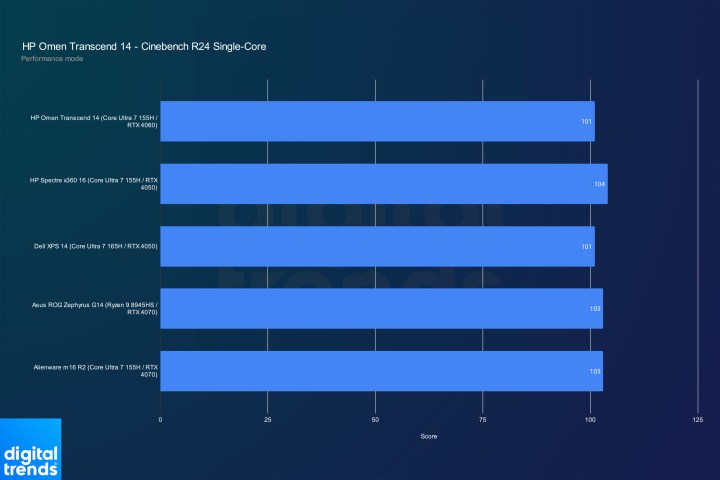
Lending more evidence to that is single-core performance, where the Omen Transcend 14 is just a bit behind what we expect out of this CPU. It’s not a huge deal in one direction or the other, so don’t take the subtle differences here as something that will meaningfully impact single-core performance.
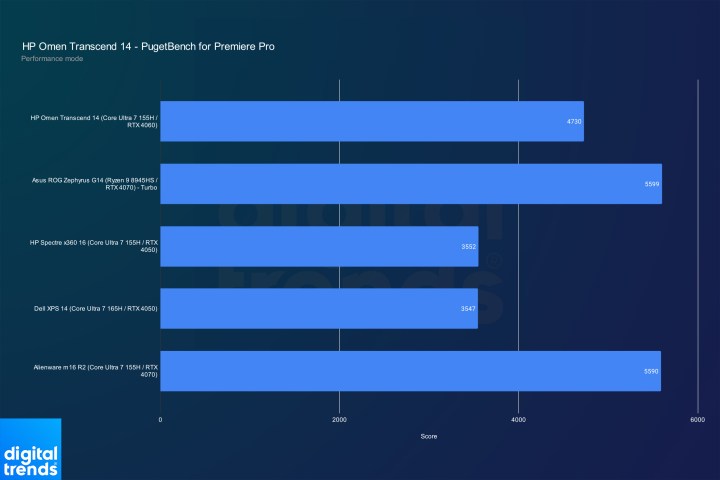
Breaking out of synthetic benchmarks, the Omen Transcend 14 is strong in Premiere Pro. It gets close to even the Zephyrus G14, despite that laptop sporting a faster GPU.
Unfortunately, I didn’t have a chance to test the configuration with the RTX 4070. Given the performance of this configuration, however, I wouldn’t be surprised if the Omen Transcend 14 is able to match the performance of the Alienware m16 R2 with an RTX 4070.
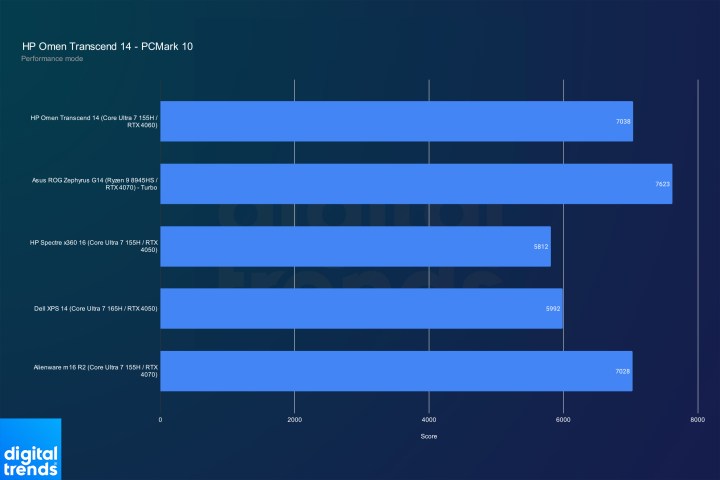
Ending with PCMark, the Omen Transcend 14 managed to outclass the Alienware m16 R2 with the same CPU, despite Alienware’s laptop using a faster GPU.
Game performance
The Omen Transcend 14 isn’t about peak performance, and that’s OK. The GPU runs at 90W, likely to accommodate the the USB-C charger and slim body. Even with that compromise, there’s a mismatch between specs and performance, particularly with the RTX 4060 configuration.
Starting with 3DMark, the Omen Transcend 14 doesn’t impress. In both Time Spy and Fire Strike, it’s behind the Acer Swift X 16, despite that laptop using the weaker RTX 4050. The most direct comparison is the Alienware x14 R2, however. Using the same GPU and a last-gen CPU, Alienware’s laptop is still markedly faster.
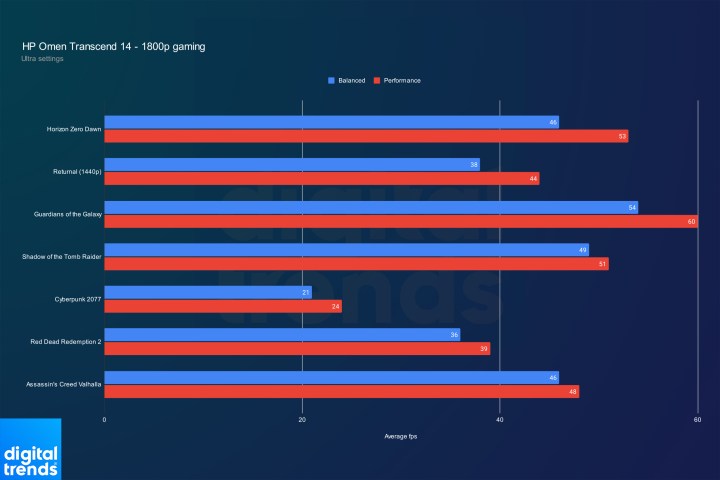
That’s not the primary issue facing the Omen Transcend 14, however. The screen is. Above, you can see a range of benchmarks at the native 1800p resolution. Even in Performance mode, the only game to crack 60 frames per second (fps) is Guardians of the Galaxy.
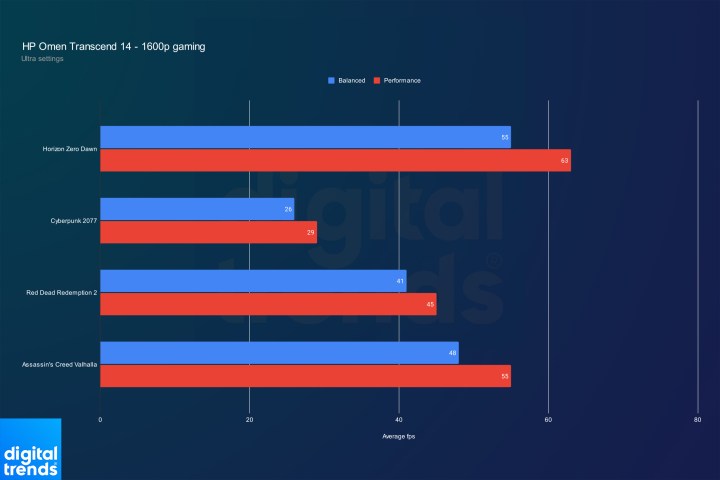
Stepping down to 1600p, Horizon Zero Dawn also joins the 60 fps club, but every other game fails to cross that line. The resolution of the screen on the Omen Transcend 14 is simply too high for the RTX 4060 to run games at native resolution. The RTX 4070 will perform better, but as we saw with in our 2024 Zephyrus G14 review, even that GPU can struggle at this high of a resolution.

Thankfully, you have access to Nvidia’s DLSS with the RTX 4060, and the Omen Transcend 14 holds up a lot better with DLSS turned on. Most games cross the 60 fps line with the usable Balanced mode of DLSS.
You can get playable performance out of the Omen Transcend 14, but almost never at true native resolution. You’ll need to use DLSS or turn down graphics settings in most games — or simply resort to running games at a lower resolution. Thankfully, even 1600p looks good on this display, so it’s not too big of a compromise.
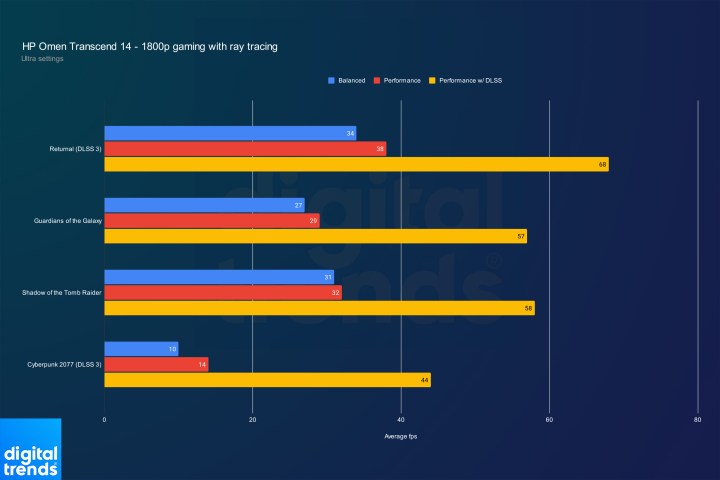
Ray tracing is on the table for this laptop, but only in small doses. As you can see, lighter ray tracing games like Shadow of the Tomb Raider and Guardians of the Galaxy work well with DLSS enabled, but more demanding titles like Cyberpunk 2077 fall short of playable, even with DLSS 3 assisting in performance.
Decent battery life
The Omen Transcend 14 has surprisingly good battery life. In our web-browsing test, the laptop lasted about five-and-a-half hours, which is a step above the Zephyrus G14 with similar hardware. HP says that may have to do with the lack of an MUX switch on this laptop. HP says the MUX switch sucked down power, so it removed the switch from the laptop.
That could explain why this machine is better than similarly configured options. Regardless, this is a gaming laptop, so you shouldn’t expect great battery life. The upside is that the 140W USB-C charger is highly portable, and both USB-C ports support power delivery.
Should you buy the HP Omen Transcend 14?

The Omen Transcend 14 is HP’s initial try at this class of gaming laptop, and it’s a great first attempt. A solid, thin, and light design pushes this beyond just a gaming workstation, and the OLED display is stunning. It seems HP focused a little too heavily on the portability of this laptop, however. USB-C charging worries me with the RTX 4070 configuration, and gaming struggles on the high-resolution display with lower-end configurations.
This is a solid gaming laptop, and if it weren’t for stiff competition from Asus at the same price, it would get a recommendation. That’s unfortunately not the case. At list price, the Omen Transcend 14 compromises a bit too much compared to the competition. However, if you spot the laptop on sale, particularly at around $1,400 for the RTX 4060 configuration, it’s a great machine.

